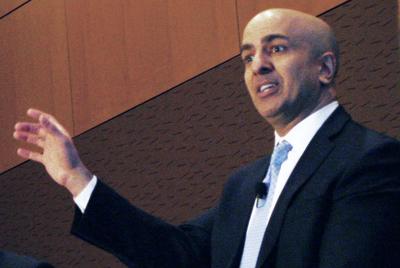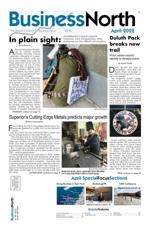Kashkari also urges local government to remove construction barriers
The labor shortage is the biggest problem that area companies currently face, and business owners must step forward to address it, the president and chief executive of the Federal Reserve Bank of Minneapolis said Tuesday in Duluth.
Stepping forward, said Neel Kashkari, means offering better pay rates to job applicants.
“Almost everywhere I go, businesses tell me they can’t find workers. I always ask them the same question: 'Are you raising wages?' Usually, the answer is ‘no.’ When you want more of something but won’t pay for it, that’s called ‘whining,’” he told the ninth Regional Economic Indicators Forum (REIF), founded and co-sponsored by National Bank of Commerce. “Until you’re paying more, I know you’re not serious.”
He blamed the phenomenon on “anchored inflation expectations” – suggesting that employers don’t believe inflation will emerge to cover their higher labor costs.
Further, he urged business owners to train workers if they lack skills, and to lower some other expectations.
Education is “enormously important,” Kashkari said, but so is on-the-job training.
“Hey – if you need to train them yourself, then you need to train them yourself.” He also advised reducing some other requirements.
“You know what? Maybe for this job we don’t have to do a drug test. Maybe for this job, we can look at people who have made mistakes and had a criminal record before,” he said. “Imagine if we tried to design a fiscal program that would motivate thousands of businesses to do these extraordinary things. With a tight labor market, and a price signal being sent across the economy, we’re now seeing thousands of businesses doing what’s best for their own interest, which is giving people a chance…to work at their business. That’s a profoundly positive move for the U.S. economy as a whole, and it’s being driven by the free market.”
Delving further, he noted the country’s population growth has slowed, reducing the amount of labor available. Kashkari argued there are only three ways to address the problem:
• Accept slower growth.
• Provide fertility incentives.
• Embrace immigration.
He encouraged companies to help foreign exchange students obtain post graduation credentials to work in this country.
“The idea that we bring students here to get a great education here, then send them home, is insanity. That’s crazy. Second, if businesses really are short of workers, and here is a skilled worker and the business has the ability to sponsor them for immigration (but doesn't) … then they’re not serious about workforce shortages. It’s really easy for businesses to say ‘I want skilled workers, and I want them cheap.’ If you want skilled workers, then you must be willing to pay for them – and if that means sponsoring someone to go through immigration, so be it. If that means paying enough to get them, so be it,” he said.
On other topics, Kashkari said:
• The impact of recent federal tax cuts remains unclear. There’s no guarantee that short-term optimism will lead to long-term economic growth.
• Tariffs on imported steel may be positive for the regional mining economy but not necessarily for the national economy. That's because there are many more steel users in the United States than steel manufacturers, he explained. “It’s hard to believe the jobs created will outweigh those negatively affected,” he said.
• Using public money to address the affordable housing shortage helps in the short term but can’t keep up with long-term demand. A better solution is to examine local barriers that keep investors from building multi-family units.
“Try to eliminate those barriers. If you add more supply, that will have an effect on price. Other than that, you’re going to be in an endless cycle of trying to find more subsidies from taxpayer money while trying to build affordable housing units. My experience is that you’ll never be able to keep up with demand for that. I don’t discourage you from doing it, but that by itself is not going to be a long term solution.”
Earlier in the twice-a-year session, students from the University of Minnesota Duluth, University of Wisconsin-Superior and College of St. Scholastica revealed findings from their Spring 2018 economic survey:
• UMD economics major Alexander Hook said the Duluth-Superior metropolitan statistical area (MSA) labor force remains smaller than it did before the Great Recession. Meanwhile, labor force participation has the lowest rate when compared with similar cities across the region. That’s likely because the average age in our MSA is higher, he said.
• UWS economics/finance student Almira Salimgarieva said consumer confidence is rising. That includes consumer sentiment for now and in the near future. “The findings coincide with national optimism,” she said.
• UWS business management student Mitchell Blomberg said the REIF’s index of regional equities outperformed the S&P Midcap 400. He predicted the regional stocks will continue along that path for the near future.
• CSS economics/mathematics student Katherine Grotte said business confidence is high – with 48 percent of respondents anticipating growing business activity. Thirty-two percent plan to hire more workers, although filling positions remains a struggle, as does finding affordable housing. Some firms are training new hires, but they fear those employees will leave their firm and take their knowledge to other companies, she said.


